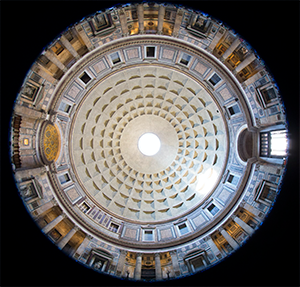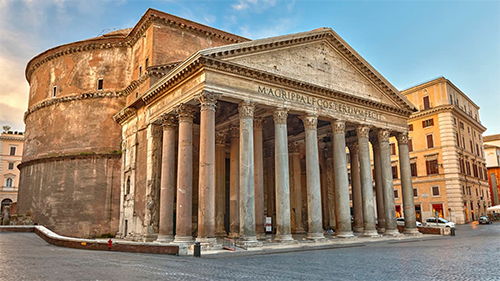The Pantheon of Rome
Marcus Agrippa, whose father-in-law was Augustus, had the original structure built about 25 B.C. The name comes from the Greek words pan (all) and theos (gods) and was designed to be a place of worship for all gods. Fire destroyed the original Pantheon in 80. The emperor Domitian ordered it rebuilt. Another fire, caused by lightning in 110, had the same result. The emperor Hadrian ordered a new Pantheon, along with many other structures. He dedicated the new structure sometime in 126–128. Historians don't know for sure who the architect was or why he and the emperor chose Agrippa's original inscription to adorn the front of the new structure. Yet the "new" building, which stands today, has over the front the words "Marcus Agrippa the son of Lucius, three times consul, made this." Historians differ on what the Romans of the time intended as the main purpose of the two-part Pantheon. The eight columns and portico that dominate the Greek-style entrance suggest a religious purpose. Statues of the gods Mars and Venus once decorated the Roman-style interior. Such a setting would have lent to the Roman Emperor a hint of divine inspiration, if not connection. Hadrian convened the Senate there from time to time. 
The iconic domed ceiling over the interior part stretches 142 feet in diameter; when it was built, it was the largest of its kind. The singular feature of the ceiling is the open space, in the form of an 27-foot-wide oculus. The diameter of the rotunda is the same as the height of the dome, 43.2 meters (141.7 feet). The checkerboard floor of the interior is sloped at an incline of about 12 inches and incorporates drain to deal with the rainfall that falls through the opening at the top. The dome inside has five rings of 28 sunken panels each. As the Empire convulsed and collapsed, the Pantheon served many purposes. In 609, Pope Boniface IV had it converted into a Christian church, known as St. Mary and the Martyrs. Thus fortified, the church fell under the jurisdiction of the papacy, which allocated funds for repair. |
|
Social Studies for Kids
copyright 2002–2026
David White



 The Pantheon as it stands today was built in the 2nd Century and finished in 180, during the reign of
The Pantheon as it stands today was built in the 2nd Century and finished in 180, during the reign of 
